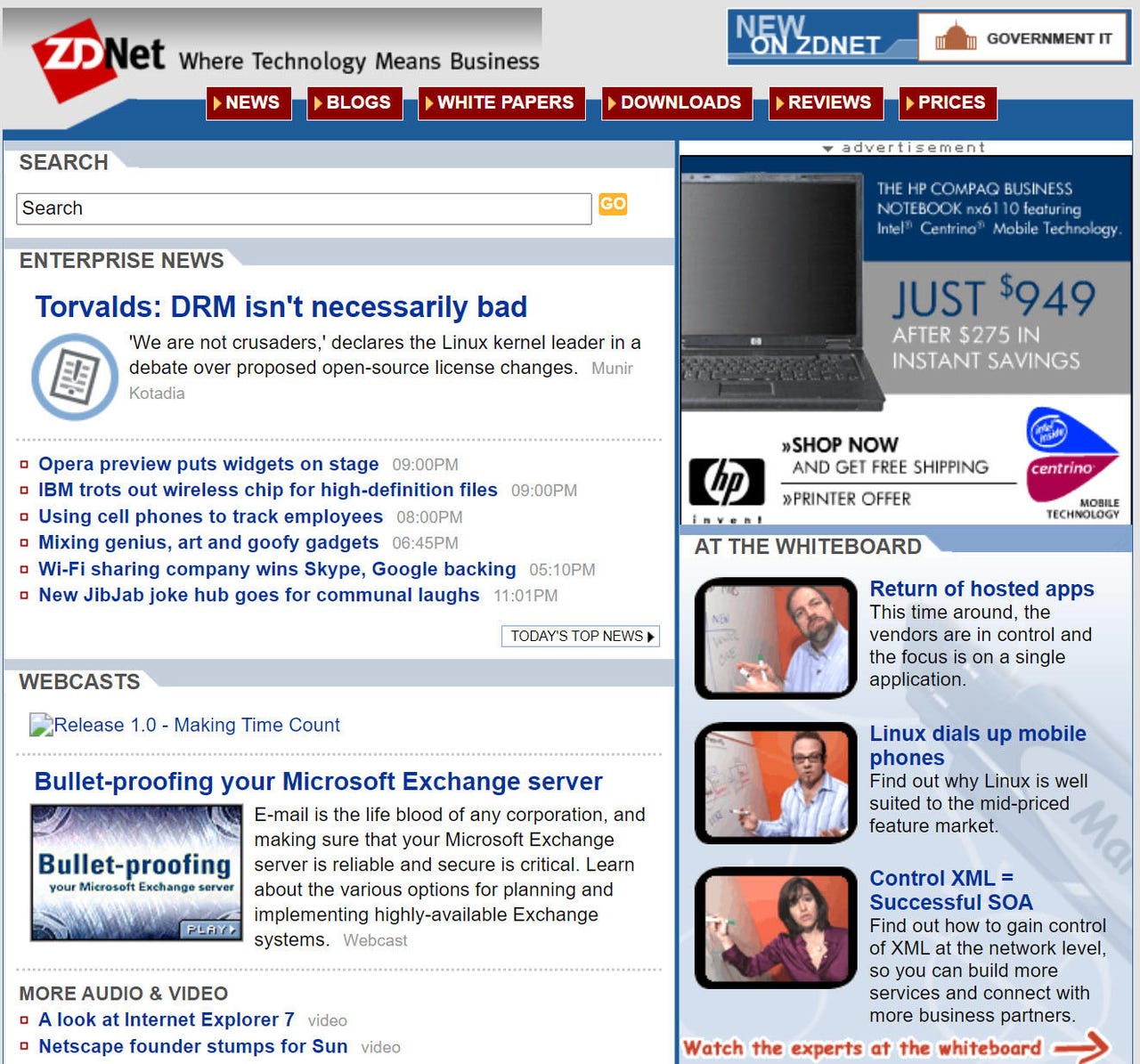15 years at ZDNet: What a long, strange trip it's been

This weekend marked the 15th anniversary of my first post on ZDNet. To mark the occasion, I went back and immersed myself in the news of the day to see how much the world has changed in the past decade and a half. It was a disorienting trip down memory lane. So many events that would irrevocably change our world were just around the corner.
This is what the ZDNet home page looked like that day, courtesy of the Internet Archive's Wayback Machine.

In February 2006, technology was mostly about PCs
In early 2006, George W. Bush was President of the United States. The leading candidates to replace him, according to a Quinnipiac University poll, were former New York City Mayor Rudolph Giuliani and a freshman Senator from Illinois named Barack Obama. Whatever happened to those guys?
tech that changed us
One bit of political news that made it to ZDNet's front page that day was a story about "the new JibJab joke hub." I won't even try to explain that to anyone who wasn't there.
American Idol was the top-rated TV show. The Apprentice, which had been a surprise hit when it debuted two years earlier, was being trounced in the Nielsen ratings by Howie Mandel's Deal or No Deal. A Microsoft employee had been a contestant on The Apprentice a year earlier, as ZDNet reported, but otherwise that show's host didn't make much tech news until a decade or so later.
In the world of technology, Microsoft was still licking its wounds after losing a history-making antitrust case at the start of the decade. The company was still making money hand over fist, however, as the PC industry was on track to ship 235 million Windows PCs that year. Windows XP was the dominant operating system on those machines, with the incredibly messy transition to Windows Vista still a year away.
Meanwhile, in Cupertino, Apple was on the verge of greatness, but no one knew it except for Steve Jobs.
The company was still called Apple Computers, Inc., and its focus (at least publicly) was very much on its Macintosh computers and the growing iPod business. (A ZDNet story that week in 2006 noted that you would be able to watch Super Bowl commercials on your iPod for the first time.)
The Macintosh product line sold a total of 5.3 million units that year, about 2.2% of the Windows PC worldwide total, and was about midway through the risky transition to Intel. In its annual report, filed at the end of 2006, Apple spelled out that risk: "The lack of applications that run on Intel-based Macintosh systems, including Microsoft Office and Adobe Creative Suite, could have a materially adverse effect on the Company's operating results and financial position."
The first "Get a Mac" ad, starring John Hodgman and Justin Long, would not debut for a few months.
The ad on ZDNet's front page for a $949 HP laptop offered a pretty realistic glimpse of what business buyers could expect. CNET's review called the "inexpensive" HP Compaq nx6110 "neither fast nor fancy, but a good fit for users who want a laptop for basic productivity work."
At six pounds (!!!) it was considered light for its class, and its 1.2-inch thickness "gives it a slender, compact look," according to CNET. Four hours of battery life was considered very good. With 512 MB of RAM, it would not have been likely to last into the Windows 7 era.
This 6-pound laptop was considered light in 2006.
And where were the mobile devices, you ask?
The first iPhone was still a well-kept secret, although there were rumors of an iPod phone. Steve Jobs' legendary introduction, in a press conference that would steal every bit of thunder from whatever forgettable news was being announced at the following year's CES, was still 11 months away.
As for Android, it didn't exist yet, at least not publicly. Google had purchased Android Inc. the previous year, and beta versions with code names like "Astro Boy" and "Bender" were in use by developers, but the first commercial Android device was still nearly three years from shipping.
This was what you used to run iTunes on a mobile device in 2006
In February 2006, mobile phones were clunky and weird. That month, ZDNet reported that Motorola was about to ship its second iTunes phone, a $300 device that worked only on the Cingular network. It was limited to 100 songs, and it looked like this:
In early 2006, if you wanted to share a story with friends or co-workers, you sent a link in an email message or maybe via AOL Messenger.
Social media? That didn't really exist yet.
Facebook was still a private network, open only to a few thousand universities and about 25,000 high schools. It wouldn't open to the general public until much later in 2006.
Jack Dorsey wouldn't send the first message on Twitter ("just setting up my twttr") until March 21, 2006, and the service wouldn't take off until a year later with a huge growth spurt at the 2007 South By Southwest conference.
YouTube was still an independent company. (It would be purchased by Google later in 2006.)
In short, 2006 was the last gasp of the PC era. Although it wasn't obvious, everything was about to change, thanks to an explosion of mobile devices, widespread broadband connectivity, and an almost unimaginable uptake of social media.
It was fun to be here in those days, and it was amusing to revisit 2006 virtually. But if you offered me a ride in your time machine, I wouldn't want to go back there. And I look forward to reading ZDNet in 2036, when I hope some enterprising columnist looks back with a chuckle at the primitive technology we poor saps were using in 2021.